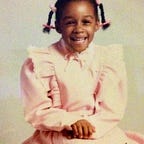When My Daughter Cut Her Locs, I Cried
I was afraid that her releasing her locs was also a way for her to release me.
Most say that my thirteen-year-old daughter looks like me. While she usually smiles politely at the constant refrain, “You look just like your mother!,” she resents the comparison. More than once she’s said, “No, I look like myself.” Yet she cannot disclaim any resemblance; she will admit that her eyes close when she’s smiling, and that when she’s old enough, she wants to sport a nose ring like her mama’s. And until recently, she had my hair.
When as a newborn, she had dark, luscious hair which ebbed to just a few strands by two. But during her third year, follicles decided to bloom. There is a distinct “before-hair” and “after-hair” moment of transition. One day, no hair. The next, hair. While the transition must have been longer than days, I remember them individually with no time between.
I told myself that I would never battle my child over her Black hair. I would never hit her with a brush for moving too much. Would never make her cry yanking or pulling at her hair. I would never have the hot comb singe her neck and tops of her ears.
But her hair refused to be tamed or handled. When I tried to discipline it, it chastened me, coiling back up the very next day.
I — graduate and law student, two other children, managing a mental illness and a marriage — was not positioned to deal with hair on a daily basis. She was four and I had another child and one on the way. I wasn’t going to fight her hair. I did what I knew to do — I loc’d it.
My hair had been loc’d for six years by then. I started and maintained my own. I started hers with small two strand twists and then combined those into larger locs. I was the only person to touch her hair from the time she was four until she was eight. As her hair grew, and I saw what I’d hope to see: a little Black girl who could do so many things with her hair. In our community where she was one of five little black girls, she wanted to do those things that white girls her age wanted to do — high buns for ballet, ponytails to the side, half up, half down. She could swim without worrying about her hair.
She did not see it that way. For her, the locs were a pretty prison. Yes, she loved the things her hair could “allow” her to do, they were not a true reflection of who she saw herself on the inside, when she was not in the mirror.
For years she’d asked me if she could get rid of them and I resisted. I told myself that my reticence was because I did not want to do her hair. But the honest reason was that I was not ready yet to let go of her hair. I was afraid that her releasing her locs was also a way for her to release me.
She combed them out over the course of a week in April, manageable because of the pandemic. I remember her walking through my door after she was done and had washed it. The smile on her face was remarkable. In front of me was a confident, happy 13-year-old Black woman-child with a firm sense of who she was. My heart both sank into my stomach and rose through my throat as I simultaneously mourned the loss of that connection and celebrated her confidence and determination.
I had to learn that she was not rejecting me but embracing herself. And, I have to be proud of myself for letting her go.
